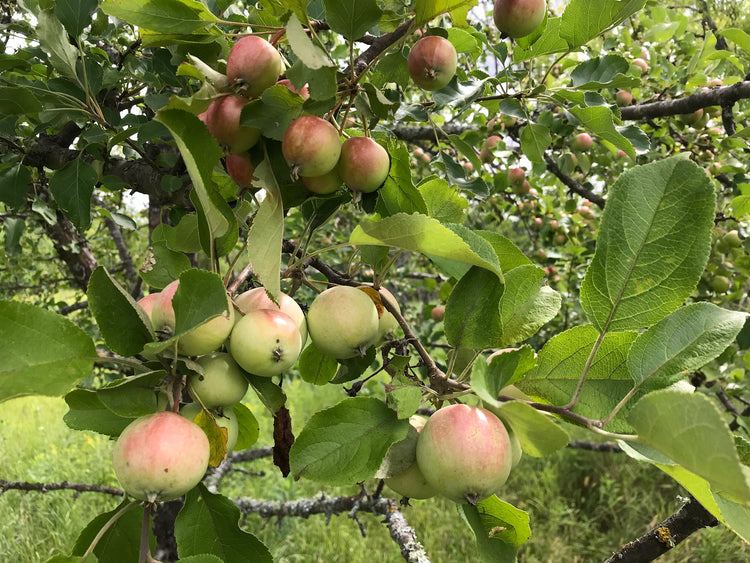Picking and Planting Fruit Trees with Food Plots
There’s no doubt about it. When you plant the right food plots in the right areas and take care to plant them well, they will be deer magnets and can be very useful for hunting applications. But when you add fruit trees to the equation and time it right, you can increase the attraction value significantly. Planting fruit trees for wildlife isn’t exactly a quick fix, especially when compared to planting food plots. It’s definitely more of a long-term strategy to boost the value of your property over time. But with the right preparation and care at planting, your trees could start producing fruit in just 5-10 years. Better yet, once they’re established, you could be looking at decades of future hunting opportunities with very little extra work.
Best Fruit Trees for Whitetails
There are a few things to think about when you’re looking for the best fruit trees for whitetails. You need to consider the overall nutrition that the fruit provides, the ultimate drawing power (i.e., attraction), time to maturity, and even the fruiting window (i.e., time of year for different varieties). Although deer eat many different kinds of soft mast, here are some of the best fruit trees to plant for whitetails.
- Apples and Crabapples – these are arguably some of the most well-known and best fruit trees for deer. Apples are full of sugars/carbohydrates, which helps whitetails pack on some fat before winter. You can find literally hundreds of different sizes and varieties of apples, some of which produce fruit late in the summer and some of which hold their fruit through much of the winter. Smaller apple varieties and crabapples work better for whitetails as they are easier to chew than larger apples we might prefer. You can also find apple varieties that grow in almost any climate zone, making it a very versatile tree. Plant several varieties in close proximity for better pollination and fruiting.
- Pears – pear trees are a little more restricted than apples in terms of where they grow, but they can be very attractive to whitetails with high carbohydrate levels too. We’re probably most familiar with European pear varieties, but there are also Asian varieties that can work in some situations. Hybrids of the two categories (i.e., Eurasian hybrids) can be a better option for deer as they usually have higher resistance to the fireblight disease. Some pears are self-pollinating, but you should plant a few trees or varieties to improve fruit set. Pear trees are not as hardy as apples though, so you need to pay attention to which zone you’re in.
- Persimmons – this fruit tree is more limited to warmer areas than apples or pears, but where they grow well, you can bet that a whitetail won’t pass them up. Persimmons are loaded with sugar, and so it’s no surprise that deer love them. Wild persimmon trees are either male or female, so you will need to plant several individual trees to ensure you have a few females that can produce fruit.
Where to Plant Fruit Trees
After selecting what kind of fruit tree (or trees) you want to plant, the next thing to consider is where to plant them. If you plant a bunch of great trees in a tough spot, the trees might suffer or it might be really hard to hunt. Spend some time planning it out before you break the ground.
- Don’t plant fruit trees in low-lying areas where cold air can gather. These “frost pockets” can severely damage the tender twigs and buds and lead to inconsistent fruiting. Likewise, high ridgetops are often too drought-prone with poor soils. Where possible, plant them on a gentle slope where the soils are loamy and well-drained.
- Very hardy varieties should be planted in full sun where they can thrive the best. If a variety is on the edge of your zone, try planting it where it is partially shaded (such as a north-facing slope), which will delay the break of dormancy until conditions are safer.
- Always plant a new “hunting orchard” somewhere near the middle of your property, which will draw (and hopefully hold) deer for longer on your parcel. Plant fruit trees upwind of where you plan to hang a tree stand or hunting blind. You may also want to plant them on the edges of existing food plots or in clusters near one to maximize the attraction value.
How to Plant Fruit Trees
Planting fruit trees isn’t hard by any means, especially if you’re planting bare root trees or smaller container-grown trees. But there are several things you can do that will really improve their survival.
Step 1: Soil Test
Since fruit trees are a long-term commitment, it helps to do a soil test to know what you need to improve over time. An ideal pH range for most fruit trees is between 6.0 and 7.5. You don’t necessarily want to fertilize new fruit trees, as the nutrients can actually burn the roots. Fortunately, there’s a way to dramatically help the young tree without applying fertilizer (more on that below). As they become established, you can apply fertilizer around the drip line each spring.
Step 2: Digging the Hole
Dig the hole no deeper than the container the tree came in, but twice as wide. This will ensure the tree won’t settle lower than the ground over time and provides some looser soil laterally for the roots to grow. Remove rocks from the planting hole so they won’t interfere with growth over time.
Step 3: Placement
Set the fruit tree in the hole and gently spread the roots out, making sure to cut any girdling roots (i.e., roots that circled around the container). Straighten roots out before backfilling to encourage them to grow away from the tree. Backfill with loose soil, gently pressing it around the root system.
Step 4: Water
After planting, you should always water your trees, which will eliminate any air pockets in the soil and help your tree recover from drying out while planting. Dried out roots will usually end in a dead tree.
Step 5: Protection
Don’t plant fruit trees unless you’re going to protect them from the elements and wildlife. Spread some weed barrier fabric around the base to eliminate grass/weed competition, and cage your tree with a tree tube or welded wire fence. Maintain the cages and fabric for several years at least until they are firmly established.
DeerGro PlotStart for Fruit Trees
When planting new fruit trees, it helps to apply some PlotStart around the roots. PlotStart is your lime replacement for acidic soils (pH under 7.0) – it works by making calcium more available and adjusting the soil pH quickly. When the pH is more in the neutral range (i.e., 7.0), it’s easier for the fruit tree to take up nutrients (e.g., Nitrogen, Phosphorous, and Potassium; or N-P-K). On a per-tree basis, mix about 8-16 ounces of PlotStart into about a gallon of water. Dump this water around the roots directly in the hole and/or on the soil surface around the tree after planting. If you have a large planting of fruit trees and a food plot in the same designated area, or you are simply applying PlotStart to the soil around already established fruit tree plots, simply follow the 2.5 gallons per acre application in those areas (2.5 gallons per acre mixed with 10-15 gallons of water).

DeerGro PlotBoost for Fruit Trees
After your trees have started growing a bit, you should give them a boost. DeerGro’s PlotBoost helps the tree with nutrient and water uptake and generally provides the tree with better resistance to drought or disease. Simply spray the green leaves and let the plant absorb them. For a single young tree, mix about 1 ounce of PlotBoost with about 24-32 ounces of water. For larger container-grown trees (or established trees), you can bump the mix up to about 2 ounces of PlotBoost. Multiply this factor of PlotBoost to water by tree in large plantings. Importantly, you should only spray PlotBoost in the early morning or late afternoon. The intensity of the midday sun shining through the water droplets can actually burn the leaves.

Compatible Food Plot Choices
When you plant fruit trees adjacent to or even within food plots, it doesn’t mean you have to give up on your food plots. They can be compatible as long as you keep a few things in mind.
- Space your fruit trees so that they are at least 20-25 feet apart. This will allow enough sunlight between the trees for decades of growth without hurting your food plots.
- Be mindful of your planting and maintenance practices. Don’t till or disk the soil too close to your trees, which could destroy the root system. Stay at least a few feet beyond the drip line of each tree. Similarly, carefully spray herbicides on your food plots and ensure there is no wind drift that could settle the chemical on your trees.
- Planting high-maintenance food plots may not be your best bet for these areas. For example, corn and soybeans may require too much disturbance to be practical. But turnips, radishes, clover, and cereal grains (essentially a great fall kill plot) don’t take nearly as much effort or maintenance to plant, are lower-growing, and they can be wonderful companions to a fruit tree orchard.
Fruit trees make an incredible addition to any wildlife property. They can produce tons of fruit per acre to help attract deer and set them up for winter. After the initial planting, they largely thrive on their own with some minor annual maintenance. And as a bonus, you can also enjoy the fruits of your labor (pun entirely intended) each fall. Use these tips to establish a fruit orchard on your land.




